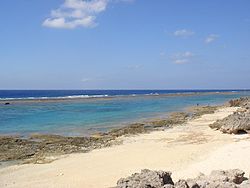Okinoerabujima (沖永良部島), often written Okinoerabu or Okierabu and in speech just Erabu, is a remote island in the Amami Islands chain in Kagoshima, Japan. It is an agricultural community that is not a common tourist destination.
Understand
[edit]
Heavily agricultural, with a population of some 12,000 in 2022, Erabu is densely populated by Amami standards, but the population declined from 14,500 in 2001. Known as Yirabu in the local dialect, the island is likely named after the black-banded sea krait, a common local sea snake. Oki no means "in the open sea", since it's 60 km north of the Okinawan mainland, and this helps distinguish it from Irabu in the Miyako Islands.
The island is administratively divided into two towns, Wadomari (和泊) to the east and China (知名, pron. "chee-na") to the west. Both the port and the airport are in Wadomari.
Tourist information site
[edit]The local tourist association has an English guide site.
Talk
[edit]There is almost no spoken or written English. Be friendly, respectful of locals, and willing to get by without English. The local Ryukyuan language dialect, Shimamuni (島ムニ), is still spoken by about a quarter of the population.
Get in
[edit]By plane
[edit]- 1 Okinoerabu Airport (沖永良部空港 Okinoerabu-kūkō). (OKE IATA). JAC turboprop flights to Amami Ōshima, Kagoshima, Naha and Tokunoshima.
By ferry
[edit]- 2 Wadomari Port (和泊港). Round trip ferries depart from Kagoshima City's south port daily, stopping at the Amami Islands, including Wadomari Port on Okinoerabu, and continuing to Naha, Okinawa. These are serviced by Marix and A-Line ferry companies. Fare is about ¥12,570 to Wadomari from Kagoshima City.
Get around
[edit]See
[edit]Okinoerabu is home to some of Japan's largest limestone caves.
- 1 Shōryūdō (昇竜洞). W-M 09:00-17:00. The only limestone cave accessible by a 600-m-long self-guided walking tour, without special equipment. ¥1,100.
Do
[edit]Diving, glass-bottom boat rides, riding a jet ski or kayak, and wind sailing are all options.
Eat
[edit]Drink
[edit]Inenotsuyu distills the local speciality, a fiery brown sugar shochu (黒糖焼酎).
Sleep
[edit]Stay safe
[edit]Unlike most islands in the region, the habu viper is absent from Erabu.

